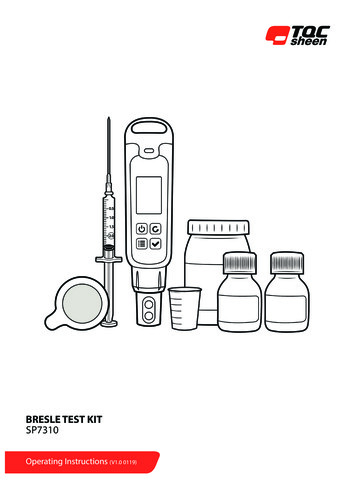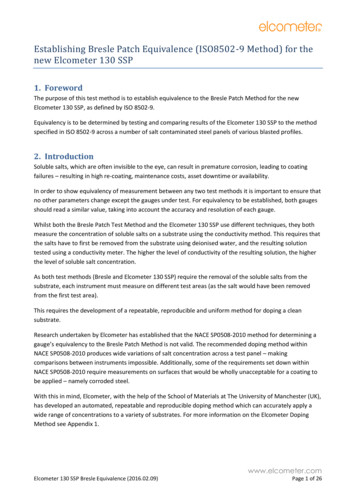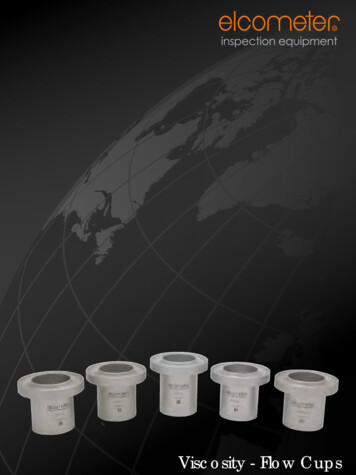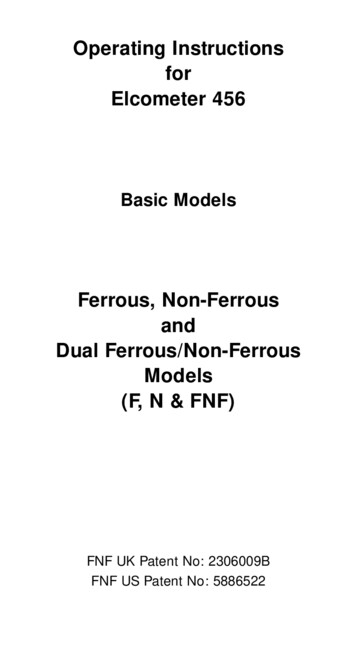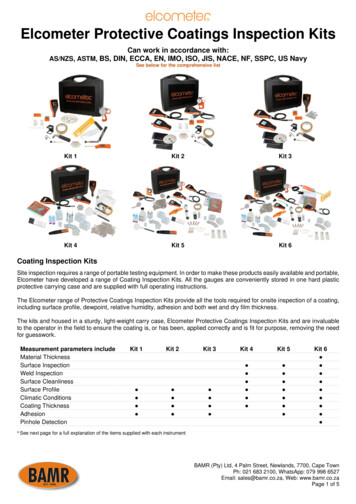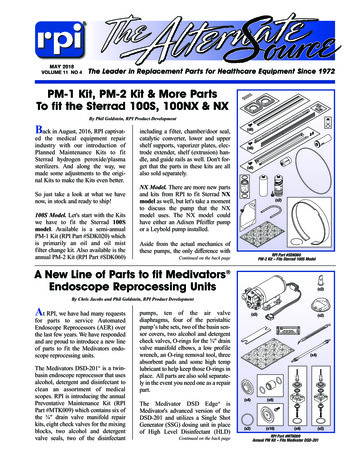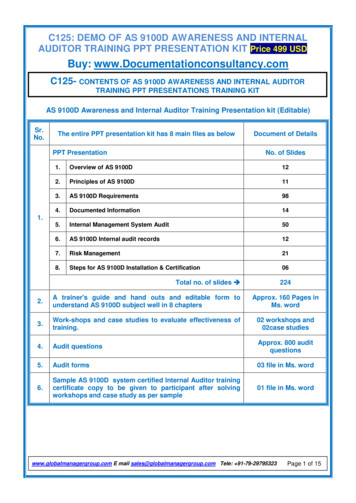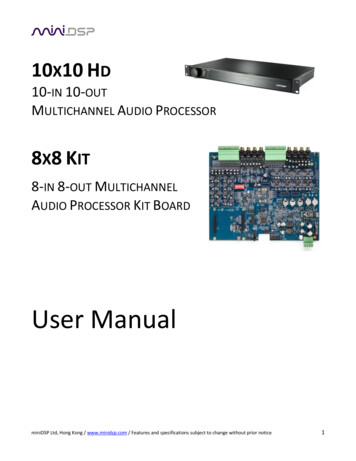
Transcription
enElcometer 138Bresle Kit and PatchesOperating Instructions
enRThis product meets the Electromagnetic Compatibility Directive.The product is Class B, Group 1 ISM equipment according to CISPR 11Group 1 ISM product: A product in which there is intentionally generated and/or used conductively coupled radiofrequency energy which is necessary for the internal functioning of the equipment itself.Class B product are suitable for use in domestic establishments and in establishments directly connected to a lowvoltage power supply network which supplies buildings used for domestic purposes.Ris a registered trademark of Elcometer Limited.All other trademarks acknowledged.A Material Safety Data Sheet for the Elcometer 138 Standard Solution is available to download via ourwebsite - www.elcometer.com/images/MSDS/elcometer 138 b771 calibration solution.pdf. Copyright Elcometer Limited. 2009 - 2013.All rights reserved. No part of this Document may be reproduced, transmitted, transcribed, stored (in a retrievalsystem or otherwise) or translated into any language, in any form or by any means (electronic, mechanical,magnetic, optical, manual or otherwise) without the prior written permission of Elcometer Limited.A copy of this Instruction Manual is available for download on our Website via www.elcometer.comDoc No. TMA–0571 Issue 02Text with Cover No. 23942
CONTENTSSection12345678910PageAbout this test kit . . . . . . . . . . . . . . . . . . . . . . . . . . . . . . . . . . . . . . . . . . . . . . . . . . . . . . . . . . . . . . . . 2Test procedure: ISO 8502-6/ISO 8502-9 . . . . . . . . . . . . . . . . . . . . . . . . . . . . . . . . . . . . . . . . . . . . . . 4Test procedure: US NAVY PPI 63101-000 . . . . . . . . . . . . . . . . . . . . . . . . . . . . . . . . . . . . . . . . . . . . . 7Using the conductivity meter. . . . . . . . . . . . . . . . . . . . . . . . . . . . . . . . . . . . . . . . . . . . . . . . . . . . . . 11Measurement . . . . . . . . . . . . . . . . . . . . . . . . . . . . . . . . . . . . . . . . . . . . . . . . . . . . . . . . . . . . . . . . . . . 16Maintenance . . . . . . . . . . . . . . . . . . . . . . . . . . . . . . . . . . . . . . . . . . . . . . . . . . . . . . . . . . . . . . . . . . . 20Storage. . . . . . . . . . . . . . . . . . . . . . . . . . . . . . . . . . . . . . . . . . . . . . . . . . . . . . . . . . . . . . . . . . . . . . . . 20Technical specification. . . . . . . . . . . . . . . . . . . . . . . . . . . . . . . . . . . . . . . . . . . . . . . . . . . . . . . . . . . 21Spare parts and accessories . . . . . . . . . . . . . . . . . . . . . . . . . . . . . . . . . . . . . . . . . . . . . . . . . . . . . . 23Related equipment . . . . . . . . . . . . . . . . . . . . . . . . . . . . . . . . . . . . . . . . . . . . . . . . . . . . . . . . . . . . . . 241enR
enRThank you for your purchase of this Elcometer 138 Bresle Kit and Patches. Welcome to Elcometer.Elcometer are world leaders in the design, manufacture and supply of inspection equipment for coatingsand concrete. Our products cover all aspects of coating inspection, from development through applicationto post application inspection.Your Elcometer 138 Bresle Kit and Patches is a world beating product. With the purchase of this productyou now have access to the worldwide service and support network of Elcometer. For more information visitour website at www.elcometer.com1 ABOUT THIS TEST KITThe Elcometer 138 Bresle Kit and Patches provides all the materials and equipment required to determinethe surface chloride contamination level. Chloride salts are extracted from the surface using the BreslePatch method and the chloride content of the test solution is measured using a Conductivity Meter.These instructions incorporate two test methods: ISO 8502-6/ISO 8502-9 US NAVY PPI 63101-000 (Rev 10)The Elcometer 138 Bresle Kit and Patches can also be used in accordance with ISO 8502-11; AS 3894.6A and SSPC Guide 15.For IMO PSPCa, the surface salts should be measured and recorded. Your Elcometer 138 Bresle Kit andPatches can be used for this.a.2International Maritime Organisation, Performance Standard for Protective Coatings
The Elcometer 138 Conductivity Meter included in the test kit measures the conductivity of aqueoussolutions. The meter is not designed to measure solids, organic solvents, surfactant, oil, adhesive, alcohol,strong acids (pH: 0 to 2) or strong alkalis (pH: 12 to 14). The life of the sensor will be extremely short ifthese substances are measured.1.1 WHAT THE BOX CONTAINS Elcometer 135 Bresle Patches, box of 25 Pure Water, 250 ml in clear plastic bottle Syringes, 5 ml, 3x Needles (blunt), 3x Beaker, plastic, 30 ml Elcometer 138 Conductivity Meter and Sensor Batteries, CR2032 lithium, 2x Standard calibration solution 1.41 mS/cm, 14ml Moistening solution, 14ml Operating instructions Carrying Case3enR
enRThe Elcometer 138 Bresle Kit and Patches are packed in a cardboard and foam package. Please ensurethat this packaging is disposed of in an environmentally sensitive manner. Consult your local EnvironmentalAuthority for further guidance.To maximise the benefits of this instrument please take some time to read these OperatingInstructions. Do not hesitate to contact Elcometer or your Elcometer supplier if you have anyquestions.1.2 CAUTIONThe needles supplied for use with this kit are blunt, but care must be exercised when using anddisposing of these needles to prevent accidental needle stick injuries. It is recommended thatused needles be disposed of as special waste, and not in landfill.If the standard solution used for calibration of the meter comes into contact with skin, wash theskin with fresh water. If the standard solution comes into contact with eyes, immediately flush theeye with large amounts of fresh water and seek medical advice.2 TEST PROCEDURE: ISO 8502-6/ISO 8502-92.1 BEFORE YOU START1. Calibrate the conductivity meter - see Section 4.4 “One-Point Calibration” on page 15.2. Wear gloves during the test. The test is extremely sensitive; wear clean latex or nitrile gloves duringthe extraction of soluble salts to prevent contamination of the surface.4
2.2 PROCEDURE1. Remove protective backing and foam centre from Bresle Patch.2. Apply patch to surface. Press firmly around perimeter of patch to ensure acomplete seal, ensuring that a minimum volume of air is trapped againstthe test surface.3. Fill syringe with 3 ml of pure water.4. Insert syringe into patch through spongy foam perimeter of the patch at anangle of about 30 to the test surface so that it passes through the foam into the compartment formed by the elastomer film and the test surface. Ifthe patch is positioned in a difficult position bend the needle as required.5enR
enR5. Inject 1.5ml of deionised water in to the patch. Do not remove the needle.Reposition the needle to remove any air in the patch.6. Remove the needle and syringe and hold the syringe with the needlepointing upwards and expel the air.7. Insert the syringe needle in to the patch and inject the remaining water.8. After a suitable period of timeb suck the solution back into the syringe andthen immediately re-inject back into the patch.9. Repeat step 8 until at least four injection/sucking cycles have been completed.10. At end of last cycle extract as much solution as possible and removesyringe from patchc.11. Measure conductivity of solution using the Elcometer 138 ConductivityMeter - see Section 5 “Measurement” on page 16.Inject sample directly into sensor cell. Rinse cell several times withsolution to be measured before taking reading.12. After the test is complete:54321 Record temperature of solution.b.c.6On un-pitted blast-cleaned areas a period of 10 minutes has been found satisfactory.During steps 4 to 10 it is essential that no solution is lost. If any solution is lost the test shall be rejected.
Remove Bresle Patch from surface and clean surface. If required, any adhesive residue from theBresle Patch left on the test surface can be removed by wiping the surface with a cloth moistenedwith a suitable solvent. Ensure that the solvent will not damage the surface before use. Rinse all components, other than the Bresle patch, of the test kit in fresh water. The components canthen be used again.2.3 TO CALCULATE THE SURFACE DENSITY OF SALTSMultiply the reading by one of these factors:Surface Density of Salts, Factors1ISO Salt MixReadingµS/cmIMO PSPC equivalent NaClmg/m2µg/cm2mg/m2µg/cm2x1.2x0.12x1.1x0.111 Based on an area of 12.5cm2 and a volume of 3ml.3 TEST PROCEDURE: US NAVY PPI 63101-0003.1 BEFORE YOU START1. Calibrate the conductivity meter - see Section 4.4 “One-Point Calibration” on page 15.2. Wear gloves during the test. The test is extremely sensitive; wear clean latex or nitrile gloves duringthe extraction of soluble salts to prevent contamination of the surface.7enR
enR3.2 PROCEDUREMeasurements shall be made randomly over the prepared surface. Take five (5) measurements every90 m² (1000 ft²). Areas less than 90 m² (1000 ft²) shall have five measurements made.1. Remove protective backing and foam centre from Bresle Patch.2. Apply patch to surface. Press firmly around perimeter of patch to ensure acomplete seal.3. Fill syringe with 3 ml of pure water.8
4. Insert syringe into patch through latex and spongy foam perimeter andinject 1.5 ml of deionised water into patch. Do not remove syringe.5. With syringe still in patch, reposition needle and evacuate any air in patch.6. Once air has been removed, inject remaining 1.5 ml of water.7. Remove syringe from patch.8. Rub surface of patch gently for 10 to 15 seconds to allow water to dissolvesurface contaminants.9. Insert syringe into patch through spongy foam perimeter and extractsolution from patch.9enR
enR10. Measure conductivity of solution using the Elcometer 138 ConductivityMeter - see Section 5 “Measurement” on page 16.Inject sample directly into sensor cell. Rinse cell several times withsolution to be measured before taking reading.5432111. After the test is complete: Record temperature of solution. Remove Bresle Patch from surface and clean surface. If required, anyadhesive residue from the Bresle Patch left on the test surface can be removed by wiping thesurface with a cloth moistened with a suitable solvent. Ensure that the solvent will not damage thesurface before use. Rinse all components, other than the Bresle patch, of the test kit in fresh water. The components canthen be used again.3.3 PASS/FAIL CRITERIAFor immersed applications, conductivity due to soluble salts (total ionic) shall not exceed 30 µS/cm. Fornon-immersed applications, conductivity due to soluble salts shall not exceed 70 µS/cm.Note: The charts produced by the US Navy for the calculation of chloride level are not required for this testmethod. Please contact Elcometer or your Elcometer supplier if you require a copy of these charts.10
4 USING THE CONDUCTIVITY METER4.1 CAUTIONDo not drop the meter.Never apply undue force when opening the meter (to change batteries/sensor).Do not exert undue force on the sensor.Do not allow utensils (tweezers, pipette etc.) to touch sensor cell.Do not measure samples hotter than 40 C (105 F).Do not allow contact with solvents.Do not subject the meter to high temperature or humidity.11enR
enR4.2 FITTING BATTERIESThe Elcometer 138 Conductivity Meter and Sensor use dry cellbatteries only. Two CR2032 lithium batteries are supplied in the kit.To fit or replace the batteries:1. Place batteries in battery clips ensuring correct polarity.2. To reassemble meter, slide sensor onto body of meter and pushbody and sensor together gently until sensor retaining clipengages.When battery voltage becomes low, Low Battery Warning Indicatorwill flash. Replace both batteries immediately.Note: Lithium batteries must be disposed of carefully to avoidenvironmental contamination. Please consult your local EnvironmentalAuthority for information on disposal in your region.Do not dispose of any batteries in fire.12
4.3 CONTROLS AND DISPLAYThe meter is operated using 3 buttons and displays readings and other information on the LCD screen.GUIDE TO CONDUCTIVITY METER & DISPLAY INDICATORS1Measurement CellPlace a liquid sample in this cell to measure it with the electrodelocated on the bottom of the cell.2Protection coverProtects the measurement cell and flat sensor in storage.3Lithium batteriesCR2032 x 2.13enR
enR4MEAS buttonSwitches the calibration mode to the measurement mode, activates/deactivates the reading locking function in the measurement mode andstarts/applies settings in the special setting mode.5ON/OFF buttonTurns the meter ON/OFF.6CAL buttonStarts calibration and switches items/settings in the special settingmode.7Waterproof gasketMakes the meter waterproof.8Strap eyeletA strap can be attached here.9MEAS iconFlashes until the measured value is stabilised and illuminates steadilywhen the measured value is settled, while the reading locking functionis active.10CAL iconFlashes during calibration and illuminates steadily when calibration isfinished.11Battery alarm iconIlluminates when the batteries are low and need to be replaced.12Temperature alarm iconFlashes when the measuring environment temperature does not meetthe specified operating temperature (5 C to 40 C).13Stability iconIlluminates when measured value is stabilised.14Measured value display Displays a measured, set and status value.15Measurement unitdisplay14A unit symbol illuminates corresponding to the value displayed on themeasured value display (14).The default setting is ‘S/cm’.
Note: The above is an extract of the full Elcometer 138 Operating Instructions. For a copy of the fullElcometer 138 Operating Instructions contact Elcometer Limited or your local Elcometer Distributor.4.4 ONE-POINT CALIBRATION1. To set ‘One-point calibration’, switch the meter on, press and hold the MEASbutton for 3 seconds. Press the CAL button until CAL appears.2. Press
ISO 8502-6/ISO 8502-9 US NAVY PPI 63101-000 (Rev 10) The Elcometer 138 Bresle Kit and Patches can also be used in accordance with ISO 8502-11; AS 3894.6-A and SSPC Guide 15. For IMO PSPCa, the surface salts should be measured and recorded. Your Elcometer 138 Bresle Kit and Patches can be used for this. a. International Maritime Organisation, Performance Standard for Protective Coatings .
